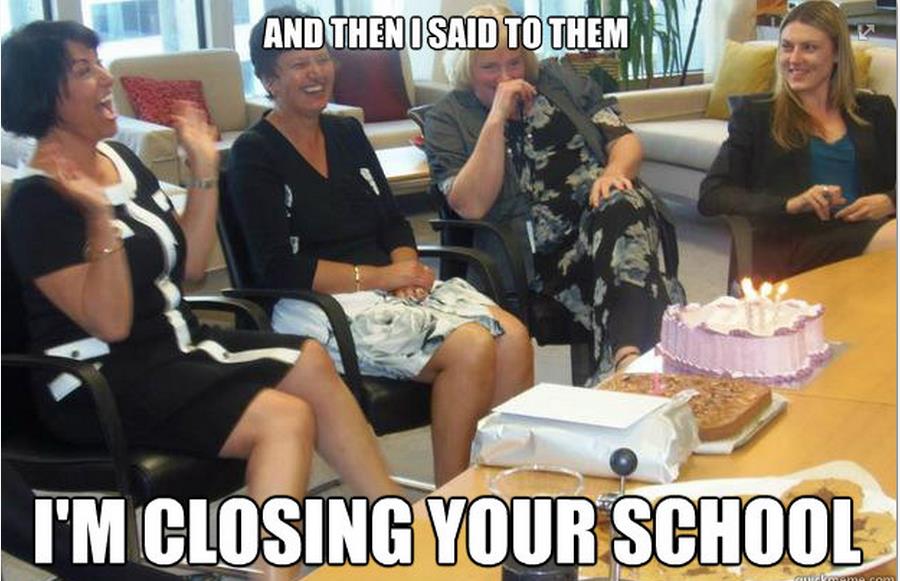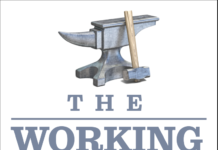Continuing the theme of my previous two articles, we now need to further unpack the government’s deceit and manipulation in their education policies. I have to give (reluctant) credit to their spin doctors, for the way in which they’ve successfully pulled wool over the eyes of New Zealand’s ‘sleepy hobbits,’ aided, of course by a compliant media.
In 2009, the government passed the National Standards Education Amendment Bill, that set the framework for the introduction of National Standards and all that has followed. In the Explanatory note, it was stated that only 56% of schools were effective in gathering and using assessment information on literacy and numeracy.
Where was that 56% figure sourced? Which reputable body drew this conclusion, on what grounds?
No one asked at the time; no one challenged the government to provide the data.
Wake up hobbits.
All will now be revealed.
The ‘reputable body’ was …. (drum roll )…. the National Party in a footnote to a 2008 election pamphlet.
Wow. Who are we to doubt that reputable body?
So how did the National Party derive this 56%, used to hammer Labour for failing New Zealand children? They took it from an Education Review Office (ERO) report in 2007. Isn’t ERO a suitably reputable body?
Well, that’s very debatable; however let’s assume for this article that, yes, ERO is a reputable body.
So, what gives then? There was indeed a figure of 56% in this 2007 ERO report. However, this 56% referred to all curriculum areas (not just the literacy and numeracy targeted by National Standards) and that it included both primary and secondary schools (secondary schools fall outside National Standards legislation).
Using this 56% to justify the introduction of National Standards for literacy and numeracy in primary schools was outrageous. Even more outrageous is that the government was allowed to get away with this, without challenge. Hello Labour?
We note here that the Education Review Office, a supposedly autonomous body, didn’t immediately come forward to protest that their data had been misrepresented, either deliberately or through ignorance. Why?
Of course, it was very necessary for the government to pull this con job. The actual 2007 report from ERO about primary schools was rather different, as Kelvin Smythe explains:
‘First, on page 20 of the Education Review Office report, the writers commented on the primary school practice of giving almost exclusive attention to literacy and numeracy and, throughout the report, on the wide range of assessment tools used. And second, on page 19, the writers say that achievement was successfully demonstrated in English by 93% of primary schools and in mathematics by 91%.’
Source.
So much then, for the ‘official’ justification for the introduction of National Standards to ensure primary schools adequately assessed children’s ‘achievement’ in literacy and numeracy.
This was a scam, a deliberate scapegoating of schools, principals and teachers. This is yet another example of the deliberate mistruth and manipulation that characterises this government, and which will define their legacy in future years.
Let’s unpick the basis for the spurious claim of ‘one in five’ not achieving.
This was based on the results of the Programme for International Student Assessment (PISA) test which was developed by the Organisation for Economic Co-operation and Development (OECD). Sample groups of 15 year olds from approximately 70 countries are tested on their reading, mathematics and science abilities.
The results of these tests are then used to rank countries’ performance in league tables. Significantly, test results are scaled to enable meaningful comparisons, so that published results don’t necessarily reflect actual scores.
There is no direct correlation between the test results of the 15 year olds and primary schools. Any interpolation of the data to predict primary school influences will not necessarily be reliable or valid.
This Wikipedia article gives a very good outline of PISA. Respected British educator Stephen Heppell presents a very critical overview on this website. and The Economist also raises some issues in Pisa envy.
The other ‘smoking gun’ behind the government’s education policies was a publication by McKinsey & Company in 2007, updated in November 2010, entitled How the world’s most improved school systems keep getting better. The 2010 edition was based on an analysis of school systems in ‘Armenia, Aspire (a U.S. charter school system), Boston (Massachusetts), Chile, England, Ghana, Hong Kong, Jordan, Latvia, Lithuania, Long Beach (California), Madhya Pradesh (India), Minas Gerais (Brazil), Ontario (Canada), Poland, Saxony (Germany), Singapore, Slovenia, South Korea, and Western Cape (South Africa).’
Right. ….. a very representative sample of the world’s school systems…..
McKinsey & Company describe themselves as ‘…..a global management consulting firm. We are the trusted advisor to the world’s leading businesses, governments, and institutions’. This apparently makes them educational experts.
The question has to be asked – why is PISA given so much credence?
Moving on: PISA results for New Zealand students consistently rank this country in the top half dozen. The scales are skewed somewhat by the ‘long tail of underachievement’ which is the source for the claimed one in five (20%) failures.
However:
‘The PISA report shows fourteen percent of New Zealand students achieve below Level 2 (the OECD benchmark for life success). The OECD average is 19%. Sixty-six percent of New Zealand students achieve at Level 3 or above. The OECD average is around 57%. New Zealand has 37% of ‘resilient’ those who overcome disadvantaged backgrounds. The OECD average is 31%.
Analysis after analysis demonstrates that given the degree of poverty, New Zealand does better than any other country in the world at educating children from families in poverty.’
Kelvin Smythe
So much for the one in five sound bite. The analysis above shows the true ratio is one in seven and that this is better than the OECD average.
Further analysis, allowing for the effects of the inclusion of students with learning needs, and those with English as a second language, suggests that the actual figure is about 8% (one in twelve). For comparative purposes, it needs to be noted that many other countries do not include these students in the testing groups.
But wait, there’s more.
In August 2012 Hekia Parata made a speech in which she claimed New Zealand was 7th in 2009 rankings, behind the countries of Singapore, Hong Kong, Shanghai, China, South Korea, Finland, and Canada.
Actually my counting on this list has New Zealand in 8th place. Someone is not achieving in numeracy. Last time I looked Shanghai and Hong Kong were part of China. Someone is not achieving in geography either.
China is not an active participant in PISA (or the OECD for that matter) and the testing was in identified schools rather than randomly selected schools. That immediately moves New Zealand up the rankings. Hang on, Singapore is not a member of the OECD and also just tests in identified schools.
That means the real rankings were Finland, South Korea, Canada and New Zealand.
Finland, of course, is the acknowledged leader in education, based on a child centred holistic philosophy of education that is opposite to the standards based policies being implemented. The differences between South Korea, Canada and New Zealand were statistically insignificant.
If Canada included First Nation children in their testing programme then their results would probably drop below New Zealand.
I don’t see any educational crisis here. Do you?
National standards, charter schools, and other government policies have nothing to do with education. Lies. No other word is suitable.
PISA does reveal a concerning picture. Maori and Pasifika students form the bulk of the underachievers. Why?
Consider:
Research has shown that one in five children live below the New Zealand poverty line.
Maori and Pasifika children form the majority of these children.
International research that shows that the predominant influence on children’s ‘achievement’ at school is their socio-economic background.
New Zealand’s mythical ‘one in five’ failure rate is therefore a direct result of the inequality in our society and so shines the spotlight on the failure of successive governments over the last few decades. That’s where the true blame lies.
Rather than address poverty, the government instead scapegoats schools, teachers and children, imposing a ‘back to basics’ curriculum on all children (excepting private and charter schools of course).
And there is the real story behind the underachievement of New Zealand students.
Maybe the government would be far better off implementing a living wage for all?







Here, here. Isn’t it so frustrating that we teachers work out butts off for the betterment of out students and it’s actually Government policy and social circumstances that is the cause of their ‘failure’ in most cases. Interestingly these are the families having most of the children now too, so what will the future bring as far as achievement is concerned. Whose ‘fault’ will those failings be???
Thank you Allan for a clear explanation of how National ‘fudged’ the figures and misled NZers about educational achievements. Ms Parata should be publically challenged about this. My yr11 and yr13 daughters, both geography students, were horrified and amused by the Education Minister’s China, Hong Kong, Shanghai gaffe.
Thank you for clarifying the mis-truths the current government has used to undermine confidence in our education system.
The real concern, is what can be done about the situation. The depth of discord and separation between the Ministry of Education and the teaching profession is considerable. It is the worst it has been in my short 25 year career in education. At times I feel the advisors in the MOE do not necessarily agree with the government policy, but they of course continue to pedal on the same bike.
Even if Labour did regain office in the near to medium future, what would they actually change?
We have already damaged our rich curriculum with the implementation of National Standards.
Yet we continue to work to encourage improvements for all our children right across NZ.
I suppose the real issue is to ask why ‘opposition’ politicians are asleep at the wheel. Given that the government leaves ‘open goals’ such as those detailed in this article, and that there is implacable opposition from the sector to these education policies, why do they still get this nonsense through the legislature?
It was equally hard to believe an argument being made on National Radio this morning by someone advocating an increase in government subsidies to private schools… because is would ‘save the country money’. The Education sector in NZ is really on the back foot and should have taken a much stronger stance years ago when Tolley was minister. It is called a ‘strike’ in case anyone has forgotten.
You can’t make this $#it up !! Ever wonder why 30,000 Kiwis are off to Aussie every year?? Key will win the next election then we’ll really be hammered. The ground has been prepared.
A very pointed article, and should be required reading for every MP and MP staffer, and for every person employed by the Ministry of mis-Education.
It’s social control, of course, by an elitist Government who will choose to misrepresent the meaning of ‘elitist’. By elitist, I mean ‘Fat Cattist’, in particular of the type who thinks wealth confers merit. Far from educating children to become good citizens steeped in democratic principles, this bunch of thugs and hired assassins that calls itself National, wishes to broaden the gap of real education, and ensure those that survive it will be biddable slaves to ‘The Man’. Quite how the Maori Party is managing to square its support for National with the effect that support is having on their own, I can’t think.
(Just as an aside. Non-Maori myself, I’ve never considered myself eligible to vote for the Maori Party. But I’ve seriously looked at Mana as a possible recipient for at least my Party vote. What does that tell you? Yeah, all right: I’m a flake…)
That Parata’s policy actually included increased class sizes as one of the means to achieving higher educational success in my view brands that Minister as the type of innumerate, illiterate and cloth-headed oaf who should never, ever, have been entrusted with the Education portfolio.
[…] the very suspect PISA testing, New Zealand is at the top of the rankings, as I showed in this previous posting. Finally, the country most highly regarded educationally is Finland, who have developed their […]
[…] I detailed the real achievement of New Zealand teachers and education in this article How true are National Party claims that our public education system is failing students? […]
Comments are closed.